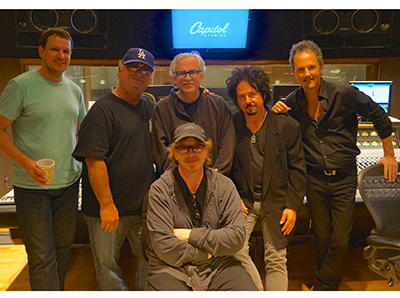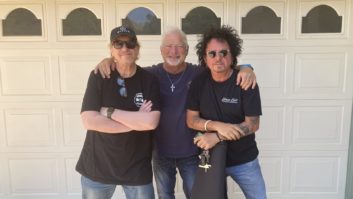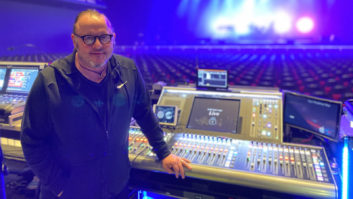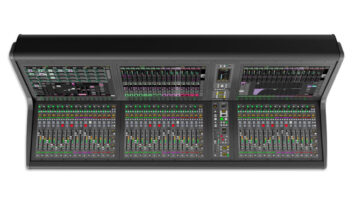
Everything about Toto XIV puts the band of seasoned musicians back in the garage where they started as buddies in 1977. Just a bunch of guys making music in CJ Vanston’s control room at Treehouse Studios—sans lounge, hot tub, pool table and videogames—where, with Vanston at the helm, they made their first studio record since 2006, every bit as good as their 1983 six-Grammy grab for Toto IV.
Seated in the cozy studio, Steve Lukather, Steve Porcaro, Joseph Williams and CJ Vanston (David Paich was on vacation) all agree that the 10-month process, which began as mere record company fulfillment, was one that felt like a band again, honoring the past and bringing the music into the present.
“This is the first time the four of us have made a record together since the ‘80s,” Lukather says. “We had all worked on things together, but this is the first time we were all encouraged to write and do a project as a unit. And I brought CJ in. I thought he’d be a great guy to keep us, A) motivated and he gets great performances, and B) keep us from killing each other—because we get very passionate about our feelings about stuff.”

CJ Vanston, left, with Joseph Williams at the Treehouse Photo: CJ Vanston.
“I always felt that if I’m not in some way pissing the other guys off, I’m not doing my job,” Porcaro interjects.
“You did a great job,” Lukather says. They all laugh.
Vanston says when there were disagreements, his role was “Switzerland.” “A little arbitrator, a little Dr. Phil,” he says. “I found a way of, ‘I hear what you’re saying,’ and ‘I hear what he’s doing, let’s put your chocolate in his peanut butter.’” But, he says, the final call was always a vote. “This isn’t some band of 25-year-olds from Iowa where I would say, ‘This is how we’re doing it,’” Vanston says.
He adds that even though he’s there to honor the vision of the band, sometimes, “You have to, more than gently, suggest things. There’s a little bit of marriage counselor built into the job. After 35 years together, it’s a marriage. They’ve been together since high school.”
And, he says, sometimes even the late, original member Jeff Porcaro was considered when there was a tie. It was: “‘Jeff would have hated that part.’ Jeff was in the room.”
Original bassist David Hungate returned after 33 years for a couple of tracks, and to tour. “It was the perfect thing,” Porcaro says. “It felt like coming home. As far as Mike [Porcaro, bassist] hearing about it, too, there was no one more excited, so that put a smile on his face.”
“If we couldn’t have Mikey, man, for Hungis to come back was great,” Lukather adds.
Mike Porcaro joined Toto when Hungate departed in 1982, shortly after the release of Toto IV, but was forced to retire from the band when he was diagnosed with ALS in 2007. Hungate’s pocket on “Holy War,” “China Town” and “The Little Things” will definitely conjure up a familiar musical feel for Toto aficionados.
Add that to Steve Porcaro and David Paich’s prolific keyboard parts, guitarist Lukather’s searing solos, the signature Joseph William vocals and lush Toto harmonies and XIV is IV in the 21st century. And, yes, there is a song title on this album by that name.
It’s also no coincidence that producer Vanston grew up playing Toto covers in Lansing, Mich., and then cut his musical teeth as a session player in a rhythm section in Chicago that was called “the Toto of Chicago.” The album bears that, along with a serendipitous meeting with the late Greg Ladanyi when Vanston moved to L.A. in 1988. Ladanyi had helmed four Toto albums, including Toto IV and he became Vanston’s best friend and a mentor of sorts.
Through Ladanyi, Vanston was soon in the studio making records with one Toto member or the other, and before he knew it, he was playing keyboards on “The Other Side,” on Toto’s Kingdom of Desire.
“There I was in the studio with Steve Porcaro and David Paich, two of my biggest keyboard heroes in life,” Vanston says. “They dug what I did.”
Years later, while Vanston was making records for Harry Shearer of Spinal Tap, he called Lukather to play on those at the Treehouse. He loved what he heard and asked Vanston to start producing his solo records. After two of those, “All’s Well That Ends Well” and “Transition,” the band brought CJ in to produce and mix their 35th anniversary Live in Poland DVD, a hugely successful project worldwide that was released in 2014. Toto XIV will be released in North America on March 24.
Into the Treehouse
This time around, the record began with demos, which everyone brought in and “which were pretty ridiculous,” Vanston laughs. Williams did a lot of writing with Paich, and Lukather and Vanston wrote at the Treehouse, while Porcaro brought his own in. The recording was done piece by piece, with everyone in the small, homey room.
“The demos are the masters these days,” Porcaro says. “We’re not chasing after demos anymore like we used to. We’re able to keep it all now. Whereas that magic used to be typically on a cassette that we’d be playing for each other, now it’s on a separate track.”
“It’s so great because you’re originally writing music and you capture something,” Lukather adds. “There’s a lick and a way you play, a sound that you maybe didn’t think about too much when you did it and it was magical. And we can transfer different things and take everybody’s stuff and say, ‘Let’s use that bit from here,’ and there’s no need to redo things.”
They all agree that the epic production piece “Great Expectations” was somewhat of a challenge, with a lot of different sections.
“I’ve always looked at it like it’s the musical version of a big budget motion picture,” Williams says. “We make Star Wars movies. We don’t make small indie movies.”
After the demo rundowns, Vanston says, recording typically started with the drum groove and a basic keyboard or guitar track next. “Then a vocal idea and then we’d start building,” he continues. “We would build some harmonies on top of that, a second guitar part, an acoustic part, an acoustic piano, some synths and start sprinkling the fairy dust on.”
When they cut electric guitars, Vanston describes the scene with him at his station and Lukather behind him on a stool, “like we’re riding a motorcycle and he taps me on the shoulder when he wants me to stop, like he’s driving a tank. It’s very low-tech and homey.”
Vanston says he mixes throughout the entire process—something he learned from Ladanyi—and is always messing with sounds and levels while he’s recording, in the moment. For instance, he says: “EQing the vocal… ‘Oh, the vocal is a little tubby. I’ll put some EQ on that. I’ll put a little compression on it, put cool reverb. Oh, wait, we want to have an echo on that one word? Well, let’s do that, I’ll put it on another track.’ Why would I want to tear all that down and start again at the end of the project? It’s valid work at the moment with everybody in the room, all being captured. It’s so powerful. All those creative decisions are being logged and documented. Then the next time I pull the song up, it sounds great.”
“And when we add the drums, the songs are already nearly there,” Vanston says. “We mute the machine drums we used that oftentimes sound really good, we drop the real drums in and there are some adjustments with the bass. The same with the real bass. A lot of the demos had synth bass as placeholders.”
He can’t understand why anyone would do it any other way. “My God, you’re making mix moves—‘That’s cool, put that up, that’s great,’” he says, as if they’re recording. “So now, six months later, I’m going to pull that fader down? I’m writing automation moves all the time.”
Vanston works in Logic, as do Porcaro, Paich and Williams. “I absolutely love Logic,” he says. “It’s so much more of a musician’s tool than Pro Tools. Pro Tools is a great tool for engineers, but it doesn’t compare to Logic as a musician’s tool. Logic is so deep in its musical plug-ins. I think some people feel that Pro Tools is the industry standard so they have to use it, but when they get over here and see me working Logic, I can’t tell you how many times people go, ‘How did you do that?’ For instance, the swipe comping in Logic is phenomenal. There are so many great features.”
“Some guys have $60,000 in their Pro Tools rigs, so they feel they have to protect that, but they don’t need all that hardware anymore,” he adds. “You used to need all that because computers weren’t powerful enough, but now these computers are the brain. Roughly 80 percent of the record is stock Logic plug-ins. I use Universal Audio plugs—their stuff is fantastic—but the tools that come in Logic are ridiculous. This is a $200 program, but if it were $20,000, I’d pay it. Don’t tell Apple that!”
He is also regularly using a plug-in called EZ Mix from Toontrack, a Swedish company.
“They have people put together chains of 8 or 10 plug-ins—a gate with a limiter with an EQ with a multiband compressor, then into a tape simulator with a little flanger on it with a split reverb. These presets would take you 20 minutes to put together. It ships with hundreds of these presets designed by guys like Chuck Ainlay, Neil Dorfsman and Mark Needham. You basically put in acoustic guitar and here’s 75 gorgeous or quirky presets for acoustic guitar that you can bang through. When you’re looking for something different to mess up the sound a little bit, EZ Mix is a killer plug-in.”
The main mic preamp throughout was a Universal 6176, used for most of the vocals. “Either with a 47 or an Audio-Technica 5040,” Vanston says. “We used a Schoeps on some of the acoustic guitar tracks and also the Shure KSM44—that sounds fantastic. Then we used a 57 for the electric guitar. If Steve Lukather is happy with his guitar sound, I’m happy with it. And I have two Neve 1073s that we used a lot on the keyboards. I’ve got a Neve 8801, which is a great preamp that I like.”
Vanston’s interface is an Apogee Converter with an Apogee clock and that goes into a MOTU 2408 audio/MIDI interface. “It is pretty pedestrian, but it’s not inducing its own sound because I’m using the Apogee for the conversion and clock,” he says.
He is also a big fan of his Mackie Control, calling it his MVP of hardware.
“That’s one of the big reasons we’re always mixing,” he says, “because my Mackie Control is there all the time memorizing every fader move I do. That’s a great piece of hardware. I see guys that work without a hardware fader pack and I don’t know how they do it. Mixing with a mouse, that’s crazy. Plus, it’s small and to the side. I don’t have to dominate the whole landscape. I’m a keyboard player, so my keyboard is my center device.”
Monitoring at the Treehouse is through his beloved JBL 6300 Series speakers. “Greg Ladanyi started me on those,” Vanston says. “They are so fabulous. I use them with the matching LSR6312SP subwoofer. When my mixes come out of here and I go to mastering, they hardly touch them. The EQ curve is nailed. They don’t color the sound. It’s a nice rich sound, no ear fatigue.”
There are five sets of Audio-Technica M50 headphones for everyone to hear the same thing at their own listening station, each powered by an Aphex HeadPod 4. “I got them for the whole room, so when we do vocals, which we do right in the middle of the control room, everyone is hearing the same sound and everyone could control their own volume,” Vanston explains. And everyone could have a say in an intimate and easy atmosphere without complications like talkback buttons.
“It was, ‘I dig that, but why don’t you change the sound a little bit,’ and there were last minute lyric changes and it was a band vibe,” Vanston explains. “For instance, David Paich leans toward the rock and bluesy stuff. I figured being the keyboard player, he would go for the more melodic harmonically rich stuff. It was actually Steve Lukather and Steve Porcaro who were more those guys.”
Most of the work was done in that one room at the Treehouse, with the exception of overdubs at David Paich’s and Steve Porcaro’s and the drum recording of Keith Carlock at Capitol Studio B, engineered by Csaba Petocz (Korn, Metallica, Tori Amos, Vince Gill, Ben Folds, Stevie Nicks, Elton John, Sting). Petocz says his objective on the drum sound was not to “redefine a band that had been making awesome records forever.”
On the kick drum he placed a Sennheiser 421 and a Yamaha subwoofer, and on the snare drum a Shure 57 with another Shure 57 underneath. On the hi-hat he switched between a Neumann KM 84 and Shure SM81.
“For overheads I used a pair of AKG C12As,” Petocz says. “Tom mic’s were 421s and for room mics I had a 47 mono room mic very close to the drums, halfway between the kick and the snare. Then for the more traditional room mic drum sound, I used a pair of U 67 Neumanns and occasionally a C-24 from the back, just sparingly. They all went through the beautiful vintage 8068 Neve console, the best sounding Neve in town. And some compression on the snare when it needed it, but only slightly. Then what I did is go direct out when I could instead of busing it, just for that added purity.”
Everyone loved what Petocz and Carlock did on the record, which Vanston calls their “Sgt. Pepper’s.”
Only the Best
Lukather admits that while this album was an obligation, they rose to the challenge. “Once we got into it, we said, ‘If we’re gonna do this, let’s make a great one,’” Lukather says. “A lot of people say bands our age don’t have any good ideas left, they used them all up. We said, ‘No, no, no,’ we gotta break down that myth, and we had CJ to push that little extra performance thing and get the best out of us. We didn’t accept any second-rate performances, and we really pushed each other to our limits.”
And no matter how much pissing each other off they did, at the end of the day, each musician has respect for one another.
“Sometimes you piss somebody off into a great performance. Paich is famous for getting that out of me,” Lukather says. “It’s like you put five bulls in a ring with one cow, the cow being the end result of the music. We all want to ‘have our way’ with the cow.”
Again, they all laugh, and say that a sense of humor also gets them through the process.
“At the end of the day, as much as heads bump and tempers flare, we all want it to be as good as it can be,” Porcaro says.
The longevity matters. It began so long ago in San Fernando Valley. A couple were even brothers and all of them grew to become brothers.
“We’ve known each other since high school,” Lukather says. “We’ve been through every good and bad time that any people could imagine in any one family.”







